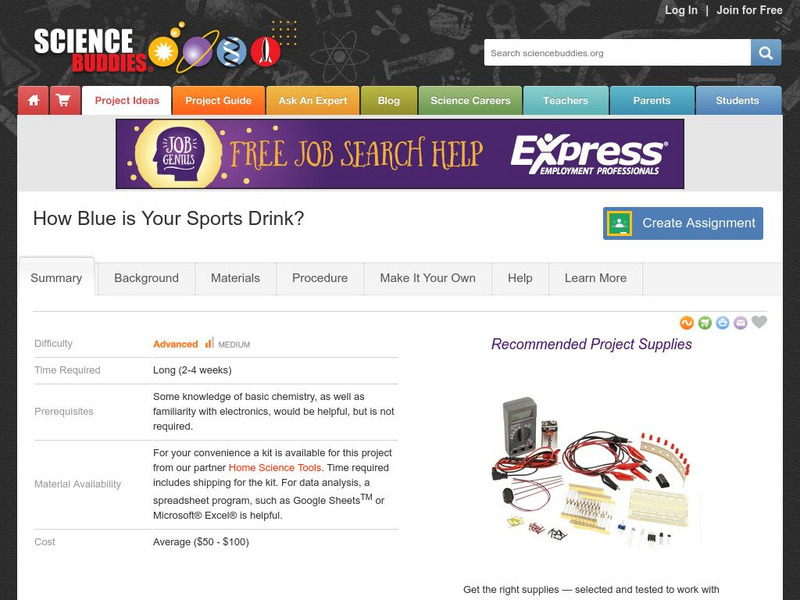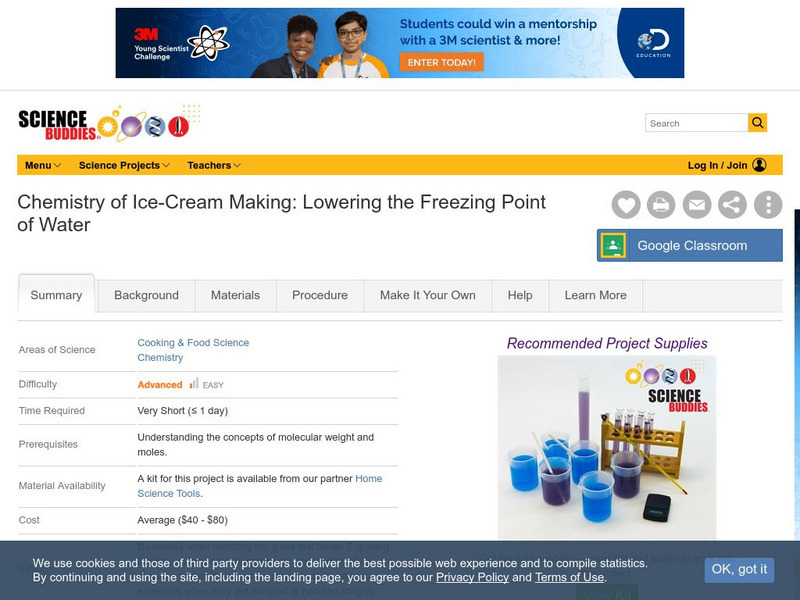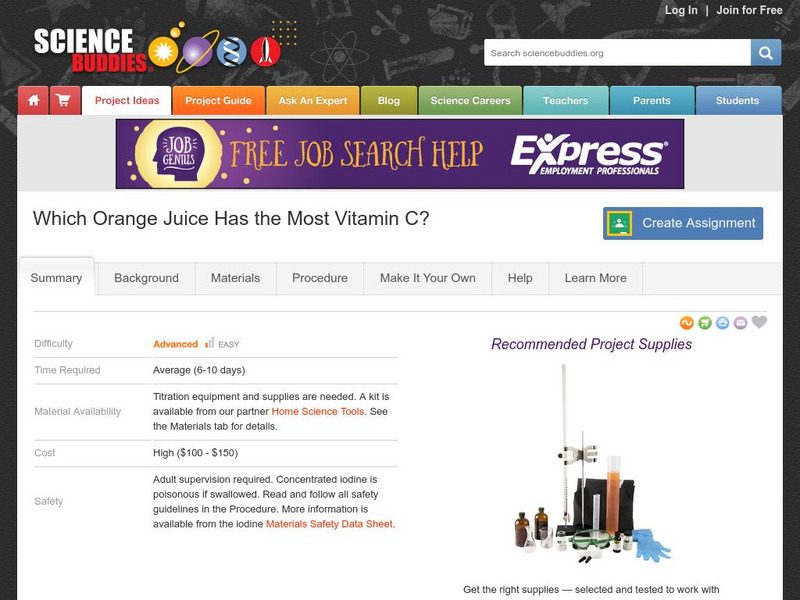Science Buddies
Science Buddies: How Blue Is Your Sports Drink?
Do you read the list of ingredients in foods and drinks before you buy them at the grocery store? If you do, you may have noticed that many of the items that are blue in color have the same dye, called FD&C blue 1. In this chemistry...
Science Buddies
Science Buddies: Can Baking Soda Substitute for Baking Powder in a Recipe?
There's nothing quite like the smell of fresh-baked muffins for breakfast on a Saturday morning. If you're into baking, you might want to try this insightful project that lets you witness the chemistry behind making muffins. You'll get...
Science Buddies
Science Buddies: Determining Iodide Content of Salt
In this week long "kitchen chemistry" project you will use chemicals from the supermarket to test for the presence of iodine and iodide in salt. These are common micronutrients added to some preparations of table salt. A materials list,...
Science Buddies
Science Buddies: The Science of Making Cheese!
Oooey gooey cheese - yum. Who doesn't like a slice of warm pizza straight from the oven? There's nothing quite like a slice of pizza and a glass of milk, so what makes pizza so great? The cheese. But did you know that making cheese is...
TED Talks
Ted: Ted Ed: The Chemistry of Cookies
Short video explains via basic chemistry principles the science of baking cookies. Stephanie Warren discusses how the dough spreads out, at what temperature we can kill salmonella, and why that intoxicating smell wafting from your oven...
PBS
Pbs Learning Media: The Ruff Ruffman Show: Teacher's Guide: Kitchen Chemistry
Learn about kitchen chemistry alongside Ruff Ruffman. Students can use the videos, games, and activities from The Ruff Ruffman Show to discover how by investigating solids and liquids and exploring heating and cooling, science can help...
Massachusetts Institute of Technology
Mit: Inventor of the Week: Lloyd Augustus Hall
Inventor Lloyd Augustus Hall is featured in this brief biography who made several contributions to the food and drug industry such as his patented method for curing meats so they would keep better.
Chiral Publishing
Chiral Publishing: An Introduction to Chemistry: Important Substances in Food: Audio Book
Learn about the chemical compounds in the foods that you eat everyday. By viewing this audio book, you'll see many structural formulas of these compounds. Also find links to other chapters in the online textbook, animations, and power...
Texas Instruments
Texas Instruments: Holt Modern Chemistry: Energy Content of Foods
This probeware Lab Energy Content of Foods from the chapter Causes of Change uses a temperature probe to calculate the temperature change of the water to determine how much energy was released when food samples burn.
Royal Society of Chemistry
Royal Soc. Of Chemistry: Kitchen Chemistry: Chemical Changes During Cooking [Pdf]
Article, with embedded questions, describes the chemical changes that take place when meat is cooked when sugar is heated, and when fruits brown.
Maryland Science Center
Maryland Science Center: Caramel Chemistry [Pdf]
This activity demonstrates the Maillard Reaction, which explains how browning and flavor develop when something is cooked.
Frostburg State University
General Chemistry Online: The Poisoned Needle
A strange bird phenomenon first occurred in a small California town in 1961. Uncover how separation technologies were used to solve the amnesic shellfish poisoning mystery.
Royal Society of Chemistry
Royal Society of Chemistry: Kitchen Chemistry: Why Do Pans Stick? [Pdf]
Article about Teflon explains why foods stick to pans and poses questions about the chemistry that causes foods to bind to uncoated metals.
Royal Society of Chemistry
Royal Society of Chemistry: Kitchen Chemistry: Is All Salt the Same? [Pdf]
Lesson plan investigation into types of salts used to season foods and in recipes asks pupils to consider and whether advertisers' claims about their salt products are truthful.
Other
Chemistry Explained: Artificial Sweeteners
Discusses four artificial sweeteners that have been approved by the U.S. Food and Drug Administration (FDA). These include saccharin, aspartame, acesulfame K, and sucralose.
Famous Scientists
Famous Scientists: Artturi Virtanen
Learn how Artturi Virtanen's inventions and research in agricultural and nutrition chemistry made him a Nobel Prize Laureate.
Famous Scientists
Famous Scientists: Ernesto Illy
UNderstand more about the man behind the brand name, Illy, and consider what he did for coffee.
Royal Society of Chemistry
Royal Society of Chemistry: Kitchen Chemistry: Use of Salt in Cooking (1) [Pdf]
Instructions for experiments to see whether cooking green beans in salted water improves their taste, texture, or color.
Dartmouth College
Dartmouth College: Chem Lab: Spectra of Conjugated Dyes & Beer's Law
In the first part of this lab, you will measure the absorption spectra of two conjugated dyes and compare the results to the theoretical predictions of a particle-in-a-box model. In the second part of the experiment, you will identify...
Science Buddies
Science Buddies: How Much Baking Powder Do Quick Breads Need?
If you like to bake, this could be a good project for you. There is a purpose for each of the ingredients in your recipes, but not everyone is always aware of what that purpose may be. Though this lab takes multiple days, you will...
Science Buddies
Science Buddies: Lowering the Freezing Point of Water
When it comes to making ice cream, in order to make the mixture cold enough to freeze, you surround the container with ice and rock salt. This experiment helps you learn how the addition of salt (or other substances) affects the freezing...
Science Buddies
Science Buddies: Which Orange Juice Has the Most Vitamin C?
In this project you'll learn how to measure the amount of vitamin C in a solution using an iodine titration method. You will hypothesize which juice will contain the most vitamin C, and then compare the amount of vitamin C in three...
Chemistry Collective
Chem Collective: Camping Problem
Measure the enthalpy of a reaction and then create a solution warm enough to cook food.
American Chemical Society
American Chemical Society: Development of Baking Powder
The invention of baking powder had a huge impact on bakers' ability to produce and distribute bread to large numbers of people. The history of this lowly ingredient is presented, along with a chemistry lesson plan for secondary young...
Other popular searches
- 4th Grade Food Chemistry
- Food Chemistry Pdf
- Food Chemistry Quiz
- Food Chemistry Pancakes
- Food Chemistry Protein
- Food Chemistry Detection
- Food Chemistry Mcq
- Food Chemistry Pd
- Food Chemistry Cakes
- Food Chemistry Protien
- Food Chemistry Mc
- Food Chemistry Pancackes















